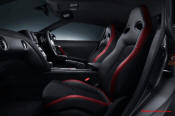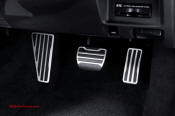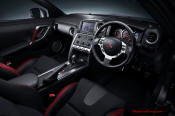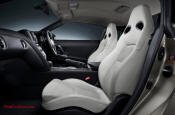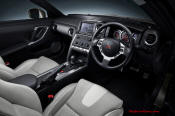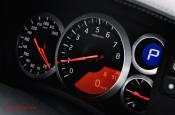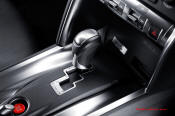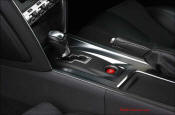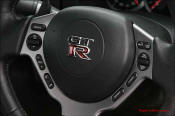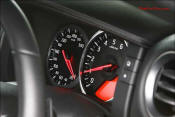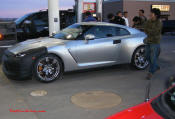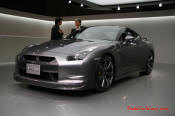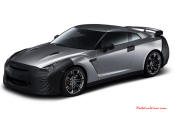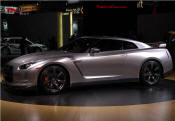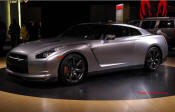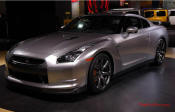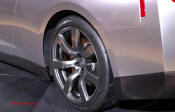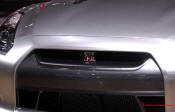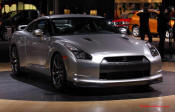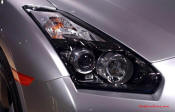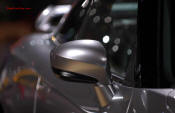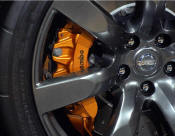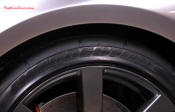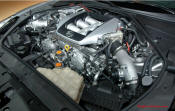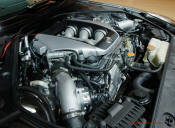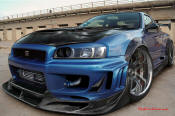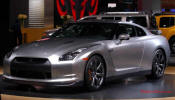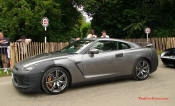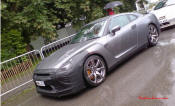|
First major reveal of Nissan supercar outside of Japan
DUBAI, United Arab Emirates (November 13, 2007) - Nissan Middle East FZE
(NMEF) will offer automotive enthusiasts a vehicle line-up that hits the
high notes in performance, luxury and elegant design when the 9th Middle
East International Motor Show opens at the Dubai International
Convention and Exhibition Centre this week.
New Nissan GT-R: the 300 km/h supercar
With user-friendly high tech and... finesse
This time, Nissan's GT-R will be sold around the world.
Nissan GT-R specifications
By anyone, Nissan means that drivers of all abilities can enjoy its
performance, from racing drivers to amateurs of particularly exceptional
sports car. Although it is going to be significantly cheaper than other
Supercars, this anyone can have it for US$ 70,000.
Anywhere refers to the GT-R development around the world, from the
Nürburgring racing circuit in Germany, to Nissan's high-speed hot
weather circuit in Arizona, to the snowy roads of Michigan. Anywhere
means also that with its four-wheel drive system, the GT-R should be at
home on dry road, snow and on wet rainy roads.
Another meaning for anywhere: unlike previous GT-R generations, the new
one will be sold in both right- and left-hand drive forms around the
world, including North America and mainland Europe. After its Japanese
launch on December 6th, with prices starting from ¥7,770,000 (nearly
US$68,000), it will reach U.S. showrooms in June 2008. It should reach
most parts of the world during the 2008 fiscal year (from 1st April 2008
to 31st March 2009).
The new body isn't taken from another production sedan or coupe.
In the end, anytime means that the Nissan GT-R is just as capable on hot
summer days as it is on snowy winter ones.
History - GT-R history started with the PGC10 GT-R in 1969. it is one of
a kind, the first in GT-R history (the last GT-R was based on the
Skyline).
Landmark features carried over from the GT-R design heritage are the
edgy box-shape of the PGC10 GT-R, the four round tail lamps of the
KPGC110 GT-R (1973), and the grille opening of the R34 GT-R (1999), a
symbolic cooling feature in the design.
The driver's seat is height and rake-adjustable and the steering wheel
also has a wide range of adjustments. The rear seats are more
'occasional' seats than full-size chairs. Comfortable for many adults on
short journeys, they are better for children.
The body is made with a combination of advanced steels, carbon fiber and
aluminum, to provide both stiffness and lightness. It uses a Premium
Midship package, an all-new platform which enables the use of the
world’s first application of an independent transaxle 4WD system. The
transaxle’s layout places the dual-clutch transmission, transfer case
and final drive at the rear of the vehicle (instead of the usual front
location), offering better front-to-rear weight balance while enhancing
leg and foot space and allowing for an optimal pedal layout.
Carbon fiber is used for the front end of the body structure, including
the radiator support and the front of the engine bay. The advanced
lightweight material gives strength, especially in any front-end impact.
Carbon fiber is also used for the rear aerodynamic diffuser under tray.
Special fiberglass is used for the engine under tray, and helps give the
Nissan GT-R a virtually flat bottom, further improving aerodynamics. Cd
is an excellent 0.27 and that's matched to good down force, crucial on a
high-performance car.
Engine - Under the hood, the brand new 3.8-litre twin turbo V6 VR38DETT
engine is specially developed for the Nissan GT-R. It produces 480PS
(353kW, 473 bhp) at 6400rpm and maximum torque of 60kg/m (588Nm, 434
lb/ft) from 3200 to 5200rpm. This makes the Nissan GT-R one of the most
powerful Japanese road cars and the most powerful production car ever
built by Nissan.
The engine features plasma-sprayed bores and special twin IHI
turbochargers. A secondary air management system helps providing
approximately 40kg/m of torque (392 Nm, 289 lb/ft) during ordinary
low-rev driving, with an optimum air-fuel ratio for around-town
efficiently and helps GT-R meet ultra-low emission vehicle (U-LEV)
standards in Japan. It features an air pump which promotes a faster
catalyst reaction
Independent transaxle 4WD system: the transaxle’s layout places the
dual-clutch transmission, transfer case and final drive at the rear of
the vehicle, offering better front-to-rear weight balance while
enhancing leg and foot space and allowing for an optimal pedal layout.
The plasma-coated cylinder liner bores are just 0.15mm thick, compared
with conventional cast iron liners of 2.6mm. They are better at
dissipating heat, improving efficiency and they're lighter, saving about
3 kg in a V6 engine. To ensure sufficient lubrication of the sprayed-on
cylinder liner in the aluminium block, special synthetic engine oil is
used: Mobil-1 RP OW-40.
Nissan considers its GT-R as the "world's most efficient supercar in
balancing speed, acceleration and fuel consumption", and gives the
official fuel consumption rate (Japanese specifications) of 8.2 km per
liter, which is the equivalent of 19.29 US mpg, 23.15 UK mpg, or 12.2
liters/100 km.
Circular analogue instruments, ringed in bezels.
The engine has an oil cooler system and in extreme cornering, a
scavenger pump maintains turbocharger oil flow. The oil collecting
structure inside the engine is optimized by a lateral wet and dry sump
system, which helps secure stable oil collecting and maintains pressure
in various driving scenes.
A collector tank inside the fuel tank always stores enough fuel to
maintain fuel flow even under strong g forces.
The engines, like the transmissions, are all hand made. One craftsman
hand-assembles the entire engine. The dedicated engine builders work in
a special Nissan GT-R 'clean room' area of Nissan's Yokohama plant.
Shift lever selector and red start / Stop button.
Transmission - The Nissan GT-R uses an all-new GR6-type transmission,
exclusively developed for the car. Unlike an automatic transmission with
conventional torque converter, the six-speed twin clutch gearbox has
minimum power loss to improve response and fuel economy.
The shift lever selector positions are Park, Reverse, Neutral, Automatic
or Manual, and manual gear shifts are via paddles directly behind the
steering wheel.
M Mode - In M range (for manual transmission mode), the paddle shift
gives very quick changes, maintaining the turbo boost, so acceleration
is one strong powerful seamless burst.
Manual gear shifts via paddles behind the steering wheel.
The twin clutches contribute to shift speed. There are separate clutches
for the odd (1,3,5) and even (2,4,6) gears. When the car is running in
an odd number gear, the adjacent even numbered gears are pre-selected
and are ready to make the shift immediately in the sequential-shifting
gearbox. When downshifting, a synchronized rev control 'blips' the
throttle precisely to synchronize engine speed for extra-fast
downshifts. Borg-Warner triple cone synchronizers are used.
R Mode - When R mode, the sportiest setting is chosen on the set-up
switch, a computerized control predicts the driver's next gear change,
based on throttle opening, vehicle speed, braking and other information.
Set-up switch allows the driver to select different settings.
A Mode - In A (automatic transmission) mode, the car changes gear
automatically, in the most fuel efficient manner. Higher gears are used
whenever possible, benefiting from the massive 588 Nm of torque, and its
long and flat torque curve. Nissan says the car can be driven in sixth
gear for long periods at low speeds, and still offers good throttle
response.
Four-wheel drive - The new Nissan GT-R is naturally rear-drive biased.
However, its all-wheel drive system (ATTESA E-TS) distributes power to
the front wheels when and if necessary. Up to 50 percent of torque can
be fed forward, improving traction in difficult conditions - such as
rain, frost, ice or snow. Front drive is also utilized to improve
cornering performance on Tarmac, improving traction and stability.
Sports steering wheel: 60mm tilt and telescopic adjustments.
A special computerized control automatically alters the front/rear
torque split from zero torque at the front wheels, to 50 percent of
total torque. The control is varied continuously, as various sensors on
the car measure speed; lateral and transverse acceleration, steering
angles, tire slip and other road surface and yaw rate.
On the new Nissan GT-R an additional sensor is the yaw-rate feedback
control, which measures the difference between the target yaw rate
calculated from the steering angle, the actual yaw rate detected by the
yaw-rate sensor and G sensor. Front and rear torque is automatically
corrected accordingly.
The four-wheel drive system includes a Vehicle Dynamic Control (VDC-R),
the Nissan GT-R's electronic stability control system. It continually
monitors the vehicle's behavior. If off balance behavior is detected -
such as sliding or skidding - torque to the wheels will be altered to
help stabilize the car.
An E-TS electronic traction control system is also fitted to rear
mechanical limited slip differentials, preventing wheel spin and
improving grip. The E-TS and rear final drive with limited slip
differential are both integrated into the compact and light rear
transaxle. The input/output shafts are placed diagonally to get a flat
transmission while lowering the car's centre of gravity.
Suspension - Nissan says the new type of suspension of its GT-R offers
"excellent straight-line stability, even over 186 mph (300 km/h), plus
top-class handling and braking in all situations - from urban commutes,
to snowy and slushy roads, to the racetrack". It is designed around the
new 'Premium Mid-ship' package.
Light and very strong die cast aluminum is used for the front suspension
strut housings, and the rigid cross brace members for both front and
rear suspension to further improve rigidity.
A set-up switch allows the driver to access three different suspension
modes: R (high performance), Sports (the normal setting) and Comfort
(for city driving to absorb road bumps). The set-up switch
electronically changes the settings on the Bilstein DampTronic dampers,
specially developed for the Nissan GT-R.
Bilstein front/rear dampers developed for the GT-R.
In R mode, the Bilsteins provide flat, hard cornering for high-speed and
maximum feedback. In the other two modes - Sport and Comfort - the
dampers are electronically controlled to produce the best possible
handling/ride balance (depending on which setting is chosen).
Special sensors measure 11 vehicle elements including vehicle speed,
lateral acceleration speed, steering angle speed, demand torque,
estimate torque, engine rpm, brake fluid pressure, normal acceleration,
ABS anti-lock braking behavior and vehicle stop information.
Brakes - GT-R features large front and rear Brembo fully ventilated
drilled steel disc brakes. Full floating rotors stabilize braking while
also preventing heat distortion. The inner parts have diamond-shaped
ventilated ribs, to ease cooling. They are also cross drilled to run as
cool as possible.
Brembo monoblock six-piston calipers are used in front and rear four
piston type. To generate strong braking force and prevent caliper
distortion, racing-style three bolt structures are used.
Front / rear Brembo ventilated and drilled disc brakes.
On an uphill gradient, which the car automatically recognizes, the
GT-R's Hill Start Assist system maintains brake pressure for about two
seconds after the release of the brake pedal, making hill starts easy.
Tires - Tires are specially developed by Bridgestone and Dunlop for the
GT-R, to offer a combination of high-speed balance, high-grip cornering
on racing circuits, great traction in the rain and comfort in the city.
The run-flat structures allow for 50 miles (80km) of driving at 50 mph
(80 km/h).
Front wing ending with a side scoop for better cooling.
Normally, run-flat tires have very hard sidewalls, to maintain tire
shape after a puncture. The Nissan GT-R's tires have unusually pliant
sidewalls, improving steering, agility and ride comfort. They are filled
with nitrogen rather than conventional air, which prevent pressure
change during high speed driving.
Dimensions are 255/40ZRF20 at the front with larger 285/35ZRF20 at the
rear. The 20-inch alloy wheel rims have special knurling to secure the
tires during very hard acceleration or braking.
Specially designed Studless tires for the GT-R are also available
through selected Nissan dealers in Japan.
Exterior – The design bears a close resemblance to the GT-R Proto of the
2005 Tokyo Show. GT-R’s low coefficient of drag of 0.27 enhances fuel
efficiency, but is also balanced with effective front and rear
down-force, for a better grip in all weather situations.
The pillars are quite upright, emphasizing that this is not an
impractical low-slung supercar.
Upright pillars, unlike an impractical low-slung supercar.
Design director Shiro Nakamura says that the mission was to achieve a
supercar, not a normal fast car, and that functionality has to be core
to the GT-R. Not too low, to keep it easy to get in and out of, with
good visibility and easy driving.
Nakamura adds: "It is clearly not an Italian, German or American car -
it is unmistakably Japanese. It is very mechanical, almost like an
animated robot... The previous R34 GT-R had the same image. It's like
you could be playing this car on a video game... We didn't want a nice
elegant shape - we wanted an original shape. Some people who buy this
car will also have a Ferrari and a Porsche. This car must be different
from all others. I see it as a car influenced not by feminine beauty,
like Italian cars, but by masculine beauty".
The front bumpers "aero-blades" on the leading edges provide airflow
around the tires and along the body. The scoop in the bumper trailing
edges assists in providing front down-force and optimization of side
airflow.
New "super wide beam" headlights feature three additional sub-reflectors
(compared to conventional lights) to give a wider spread to the
illumination area (see safety section below).
At the rear, there are the four round tail lamps mirrored in the four
round exhausts directly below. Advanced technology comes also in GT-R’s
paint – which utilizes a double clear coat and anti-chipping process and
is hand-polished.
Interior Design and instruments - The cabin gets sculpted performance
bucket seats and soft pads on the lower portion of the instrument panel
and doors to give an extra level of comfort and safety.
A special set-up switch located in the centre of the instrument panel,
enables the driver to adjust transmission shifts, shock absorbers and
the Vehicle Dynamic Control in three settings – Normal, Comfort or R,
the high-performance setting (see suspension above).
A high-speed, high-capacity CARWINGS navigation system is available in
Japan, with a 30GB hard disk drive, featuring an easy-to-use touch pad,
as well as traditional navigation switches. The screen interface
features also an entertainment system with a Music Box hard drive, DVD
and CD player, and Bluetooth audio function.
Like the exterior, Nissan GT-R's interior is meant to be stylish but
highly functional too. The cabin shares no major components or design
features with any other Nissan model. Instruments are directly in front
of the driver. The circular analogue instruments are ringed in chunky
bezels and there is a tachometer red-lined at 7000rpm. Within the
tachometer is an easy-to-see gearshift position display.
Multi-Function Display - The multi-function display in the centre of the
dash, gives a detailed log of the driving behaviour (details follow).
The design of the multi-function display, which also includes the
satellite navigation and audio controls, was done in conjunction with
Polyphony Digital Inc, designer of the Gran-Turismo video game series
for Sony PlayStation.
The multi-function display useful information includes (see opposite
photos):
Mechanical information - including engine water temperature, oil
temperature, oil pressure, transmission oil temperature, transmission
oil pressure, turbocharger boost and front/rear torque split. In every
case an individual reading can be highlighted or several different
functions can be shown in the multifunction window.
Driving information - including accelerator opening, brake pedal
pressure, steering angle and g-force both longitudinally and
transversely. An on-board driving recorder also logs driving performance
and can be a useful tool in improving driving technique.
Optimal gearshift map is shown for fuel efficiency. It shows best
gearshift points using easy-to-understand graphics, and includes both
enthusiastic and urban driving. The monitor also shows a log of
eco-driving over the previous 20 minutes.
Driving records - including routes used and time duration.
The system is easy to use thanks to both a rotary selector switch, as
well as it being a touch screen.
In the centre of the dashboard, below the multi-function display, is a
cluster angled towards the driver. It contains switches for the air
conditioning, audio and set-up switches, used to change the tuning of
components including dampers, gear shift and VDC.
The centre console, contains a red start button, leather shift lever
(the same leather used for the steering wheel) and parking brake. The
steering wheel is small and trimmed in soft hand-stitched leather.
Seating - Seats are especially designed for the Nissan GT-R. They're
heavily side bolstered for lateral support and comfort. To relax the
lower legs during longer drives, the front edge of the seat is unusually
flat; it also makes getting into and out of the seat easier.
Nissan claims that its GT-R has the greatest range of seat adjustment of
any supercar, to ensure that virtually all drivers can get comfortable
behind the wheel. The driver's seat is designed so that anyone from
144cm to 190cm will feel comfortable behind the wheel. The seat slide is
long (228mm), the seat is height and rake-adjustable and the steering
wheel also has a wide range of adjustments (60mm tilt, 60mm telescopic).
Like many high-performance four-seat coupes, the rear seats are more
'occasional' seats than full-size chairs. Though comfortable for most
adults on short journeys, they are better for children or for carrying
bags, jackets and other goods.
The center console sweeps through the middle of the cabin, dividing left
and right rear seats. Between the seats there is the provision for
optional two BOSE sound system woofers.
The trunk is large for the GT-R category (VDA: 315L), big enough for two
sets of golf bags or for substantial holiday luggage. Luggage space is
further improved.
Boot / trunk volume of 315 liters, good for the GT-R category.
The seats have three color schemes: black, black with red highlight or
grey.
Navigation, audio and video - The navigation system uses the same screen
as the multi-function meter, with a 30 GB hard disk drive to speed route
searches. It also includes an entertainment system capable of recording
up to 3000 songs (from music imported from CDs) as well as playing DVDs.
The high resolution screen with newly developed WVGA (wide video
graphics array) high resolution display is a liquid crystal monitor that
has four times the number of pixels of a conventional satellite
navigation screen. Innovative 3D graphics can depict streetscapes and
junctions with more accuracy than conventional displays. The system can
be controlled via a rotary switch or its touch-screen display. There is
also voice command and a steering wheel switch.
Automatic climate control, 30GB system for audio/video...
The 30GB system also allows for a rich entertainment system. It provides
various music selection functions, can play DVD audio and video as well
as music from memory CF cards, WMA (Windows Media Audio) and MP3
formats. By using a Bluetooth transmitter, it can wirelessly connect and
play music from an iPod. Wireless connection also allows hands-free
cellular phone calls.
A digital TV tuner allows occupants to watch TV on the high definition
screen.
Specially developed for the new Nissan GT-R by BOSE and Nissan
engineers, the sound system is matched to the acoustic requirements of
the cabin, including shapes and materials. The 11-speaker system
includes tweeters (high frequency range), squawkers (mid range) and
woofers (low frequency). There are also two woofers in the rear centre
armrest facing forward. The layout uses the trunk for speaker enclosure.
The rear centre woofers and door speakers are mounted in rigid aluminum
die cast panels, which improve sound quality, especially with tight bass
sounds.
4 round tail lamps heritage from the KPGC110 GT-R (1973).
The built-in DC-DC converter enables voltage to be amplified from the
ordinary 12 volts to 52 V, realizing a higher output. The new PWM
amplifier (switching amplifier) balances high output, high efficiency,
and light weight.
Standard safety equipment includes driver and front passenger SRS airbag
system, front seat belts with load limiters and three-point rear seat
belts. Curtain Air Bag System are also offered. Standard equipment
includes also a pop-up engine hood system for enhanced pedestrian
safety.
The door inners are also made from die cast aluminum, enhancing side
impact safety protection.
Nissan says that after investigating active headlamps that turn in the
same direction as the steering wheel, it concluded that the super wide
beam headlamps did a better job in a high performance car.
To improve active safety, the new GT-R is fitted with new super wide
beam headlamps that give a better spread than normal sports car
headlamps. Nissan says that after investigating active headlamps that
turn (usually up to 15°) in the same direction as the steering wheel, it
concluded that the super wide beam headlamps did a better job in a high
performance car - largely because they provide a better light spread in
high-speed straight-line driving. They also offer unmatched light spread
in dark cities, on winding roads, and on pedestrian crossings.
Nissan adds that compared with conventional lights, the GT-R lamps have
three additional sub-reflectors, enhancing the illumination area. They
'turn night into day' more effectively than any current headlamp design,
giving unmatched night visibility.
The new GT-R has an advanced anti-theft security system. In addition to
the usual vehicle-entry detection sensor, a further sensor detects
vehicle inclination. So if the vehicle is towed away, or inclined for
any reason (such as to steal tires or wheels), the alarm sounds.
The engine immobilizer uses an electronic ID signal between the key and
the immobilizer system installed in the BCM (body control module) for
code verification. If the system is verified, the BCM then signals the
ECM (engine control module) to start the engine. If the electronic ID is
incorrect, the engine is immobilized.
When a vehicle is locked with a keyless remote control or an intelligent
key, the system disables use of a mechanical key or door knobs inside
the vehicle to unlock. This prevents forced entry by handling door knobs
inside the vehicle to unlock.
A wheel lock nut helps preventing theft of the alloy wheels.
Manufacturing - All Nissan GT-Rs are built in Nissan's Tochigi factory
in Japan, where Infiniti models are built. Much of the assembly is done
by hand, reflecting the complex nature of the vehicle and its hand
crafted precision. Each car has a conducted run-in drive before
shipping, in addition to its regular inspections, so the very earliest
use of the brakes, transmission and suspension will be smooth for the
customer. The vehicle is fully inspected before customer delivery. |
